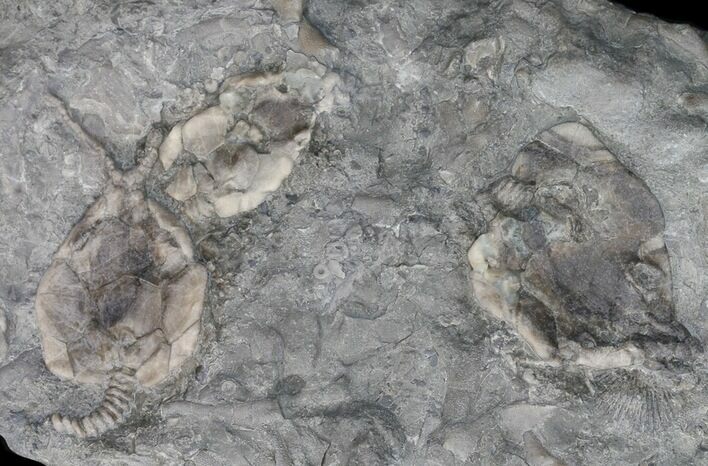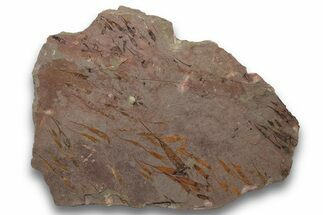This Specimen has been sold.
Triple Pleurocystites (Cystoid) Plate - Ontario
This plate 4.5x2.9" plate of limestone has three specimens of the unusual cystoid Pleurocystites squamosa on it. They were collected near Brechin, Ontario. Unfortunately almost none of the limestone quarries have allowed collecting for years, so there are very few of these being found anymore. It comes with an acrylic display stand.
Pleurocystites (meaning rib bag) is a genus of rhombiferan echinoderm - and a cystoid that lived in the Late Ordovician. Fossil Pleurocystites sp. are known from Europe and North America.
Pleurocystites squamosa grew to a height of 6 centimeters and fed on tiny, floating particles. The most distinctive feature of cystoids was the presence of a number of pores in the rigid skeleton encasing the body. These were most likely respiratory in nature, allowing fluid to flow in or out of the body.
Pleurocystites (meaning rib bag) is a genus of rhombiferan echinoderm - and a cystoid that lived in the Late Ordovician. Fossil Pleurocystites sp. are known from Europe and North America.
Pleurocystites squamosa grew to a height of 6 centimeters and fed on tiny, floating particles. The most distinctive feature of cystoids was the presence of a number of pores in the rigid skeleton encasing the body. These were most likely respiratory in nature, allowing fluid to flow in or out of the body.
Cystoids are extinct echinoderms similar to crinoids. They consist of a stalk, theca (body), and brachials (feeding arms). Most lived fixed to the seafloor, but some were more mobile. Like modern echinoderms, cystoids were arranged in a fivefold symmetric pattern and had a water vascular system. However, unlike most echinoderms, cystoids had triangular calcite plates at their body openings containing pores that are thought to have been for breathing.
Cystoids first appear in the Cambrian Period and reached peak diversity during the Ordivician and Silurian Periods. Cystoids died out at the end of the Devonian or early in the Carboniferous Period.
Cystoids resembled flowers, but were in fact animals. They had a stem that attached them to the seafloor, a theca, and brachials. The theca contained the cystoid's vital organs and was made up of calcite plates that formed a spherical or ovate body. The brachials were the feeding arms that extended from the top of the theca, arranged in three- or five-fold symmetry, and funneled food to the mouth at their center. Cystoids and crinoids look similar but have some distinct differences. The main difference is in the shape of the main body of the organisms: cystoids had a spherical or ovate theca, while crinoids had a cup shaped calyx. Cystoids also had triangular plates at body openings while crinoids had variably shaped plates.
Cystoids first appear in the Cambrian Period and reached peak diversity during the Ordivician and Silurian Periods. Cystoids died out at the end of the Devonian or early in the Carboniferous Period.
Cystoids resembled flowers, but were in fact animals. They had a stem that attached them to the seafloor, a theca, and brachials. The theca contained the cystoid's vital organs and was made up of calcite plates that formed a spherical or ovate body. The brachials were the feeding arms that extended from the top of the theca, arranged in three- or five-fold symmetry, and funneled food to the mouth at their center. Cystoids and crinoids look similar but have some distinct differences. The main difference is in the shape of the main body of the organisms: cystoids had a spherical or ovate theca, while crinoids had a cup shaped calyx. Cystoids also had triangular plates at body openings while crinoids had variably shaped plates.
SPECIES
Pleurocystites squamosa
LOCATION
Brechin, Ontario, Canada
FORMATION
Bobcaygeon Formation (Upper Member)
SIZE
Largest 1.7", Matrix 4.5x2.9"
CATEGORY
SUB CATEGORY
ITEM
#43793
We guarantee the authenticity of all of our specimens.
 Reviews
Reviews














